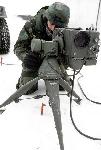Guarding Airliners From Missiles Determined Too Costly (note: is ANYONE, with the exception of bureacrats and politicians TRULY surprised at this .... "news" ??? -- A4s )

January 25, 2005, 2:30 PM EST
LOS ANGELES (AP) -- Outfitting every U.S. commercial passenger plane with anti-missile systems would be a costly and impractical defense against terrorists armed with shoulder-fired rockets , according to a study released Tuesday.
Researchers said it could cost nearly $40 billion over 20 years to deploy defense technology on the country's 6,800 passengers jets. By comparison, the federal government currently spends roughly $4.4 billion a year on all transportation security.
The study by California-based Rand Corp. also found the devices -- powerful on-board lasers that divert heat-seeking missiles -- weren't yet reliable enough for commercial aviation because of false alarms that could distract authorities and create a safety hazard.
So far, no U.S. carriers have been attacked by missiles. But two shoulder-fired rockets launched by al-Qaida-linked terrorists narrowly missed an Israeli passenger jet in Kenya in November 2002. Since the 1970s. more than 40 aircraft have been hit by shoulder-fired missiles, killing 600 people.
The availability of shoulder-launched missiles on the black market has heightened fears. As many as 750,000 shoulder-fired missiles are now deployed, with about 1 percent said to be outside government controls, according a Government Accountability Office report issued last year.
The study also suggested that reducing the missile threat involved other countermeasures such as working with foreign governments to slow the proliferation of missiles and helping local authorities set up security perimeters around airports.

 (note: HEY !! HEY !! HEY !!! That will work !!! I KNOW IT WILL --- I have GOT to get a job doing some of these "studies" -- A4s)
(note: HEY !! HEY !! HEY !!! That will work !!! I KNOW IT WILL --- I have GOT to get a job doing some of these "studies" -- A4s)

January 25, 2005, 2:30 PM EST
LOS ANGELES (AP) -- Outfitting every U.S. commercial passenger plane with anti-missile systems would be a costly and impractical defense against terrorists armed with shoulder-fired rockets , according to a study released Tuesday.
Researchers said it could cost nearly $40 billion over 20 years to deploy defense technology on the country's 6,800 passengers jets. By comparison, the federal government currently spends roughly $4.4 billion a year on all transportation security.
The study by California-based Rand Corp. also found the devices -- powerful on-board lasers that divert heat-seeking missiles -- weren't yet reliable enough for commercial aviation because of false alarms that could distract authorities and create a safety hazard.
So far, no U.S. carriers have been attacked by missiles. But two shoulder-fired rockets launched by al-Qaida-linked terrorists narrowly missed an Israeli passenger jet in Kenya in November 2002. Since the 1970s. more than 40 aircraft have been hit by shoulder-fired missiles, killing 600 people.
The availability of shoulder-launched missiles on the black market has heightened fears. As many as 750,000 shoulder-fired missiles are now deployed, with about 1 percent said to be outside government controls, according a Government Accountability Office report issued last year.
The study also suggested that reducing the missile threat involved other countermeasures such as working with foreign governments to slow the proliferation of missiles and helping local authorities set up security perimeters around airports.


 (note: HEY !! HEY !! HEY !!! That will work !!! I KNOW IT WILL --- I have GOT to get a job doing some of these "studies" -- A4s)
(note: HEY !! HEY !! HEY !!! That will work !!! I KNOW IT WILL --- I have GOT to get a job doing some of these "studies" -- A4s) 












